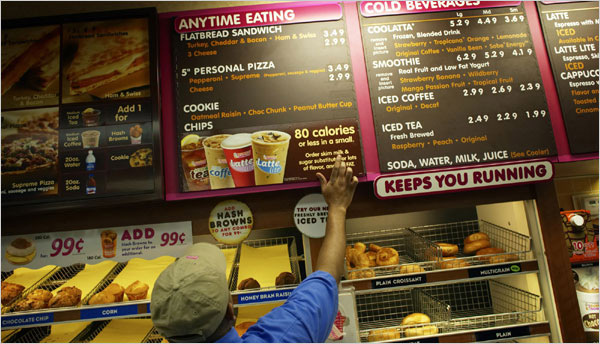
Large U.S.-based chain restaurants that voluntarily list calorie counts on their menus average nearly 140 fewer calories per item than those that do not post the information, new Johns Hopkins Bloomberg School of Public Health-led research suggests.
The findings, published in the November issue of Health Affairs, come as all American chain restaurants with more than 20 outlets and many other establishments that serve food, including ice cream shops and movie theaters, will be required to post calories on their menus beginning in December 2016. Calorie labeling, required as part of the Affordable Care Act, was put in place with the goal of steering people towards lower calorie choices, which could, in turn, help Americans eat more healthfully.
While the requirements won’t go into effect for another year, five of the 66 largest U.S. restaurant chains have already introduced voluntary calorie counts on menus in all their outlets: Panera and Jamba Juice since 2010, McDonald’s since 2012 and Chick-fil-A and Starbucks since 2013.
“The menu items in restaurants with voluntary labeling have fewer average calories than restaurants without labeling,” says study co-author Julia A. Wolfson, MPP, a CLF-Lerner Fellow and a PhD candidate in the Department of Health Policy and Management at the Bloomberg School. “If other chain restaurants follow this same trend once mandatory menu labeling goes into effect, it could significantly improve the restaurant environment for consumers. This could get consumers to eat healthier without having to change their behavior, something that is a very difficult thing to do and sustain.”
For the study, Wolfson and her colleagues analyzed data from 2012 to 2014 in MenuStat, a data set of menu items at 66 of the 100 largest U.S. chain restaurants, based on sales. MenuStat was developed and is maintained by the New York Department of Public Health and Hygiene.
Overall, the chains with voluntary labeling averaged nearly 140 fewer calories per item than those that do not post the calorie counts on menus, with much of that difference attributed to lower-calorie food rather than beverage items. In 2012, the average item at the restaurants posting their calories on their menus contained 260 calories, while the average was 399 calories at those that didn’t post calorie counts. In 2014, the average was 263 at those with voluntary labeling and 402 at those without.
The researchers also found similar results when they compared restaurants with voluntary labeling to competitors with similar menu offerings that did not have menu labeling; for example, Chick-fil-A to other chicken restaurants, or McDonald’s to other burger restaurants.
Chains with voluntary menu labeling introduced approximately twice as many new items in 2013 and one-third more new items in 2014 as compared to the other chains, the researchers found, which may reflect increasing consumer demand for healthier items in response to the transparency introduced by labeling.
It isn’t clear, however, from this study whether the chains with calorie counts on their menus were already serving lower-calorie foods before they decided to go public with their calorie counts (which could have incentivized them to voluntarily share the information), whether calorie counts were lowered in anticipation of the move or whether these chains just happened to have lower calorie counts all along.
Research has shown that consumers significantly underestimate the number of calories in the food they eat and may be surprised by how many calories certain items contain. Yet evidence suggests, Wolfson says, that few consumers actually notice calories listed on menus and that menu labeling seems to have little effect on consumer choices in restaurants.
“The biggest impact from mandatory menu labeling may come from restaurants decreasing the calories in their menu items rather than expecting consumers to notice the calorie information and, subsequently, order different menu items.” she says “Given how often Americans eat in restaurants, if more chain restaurants decrease calories on their menus to a level that we are seeing in restaurants that already label, this has the potential to reduce population-level obesity.”
The study done by Johns Hopkins Bloomberg School of Public Health.